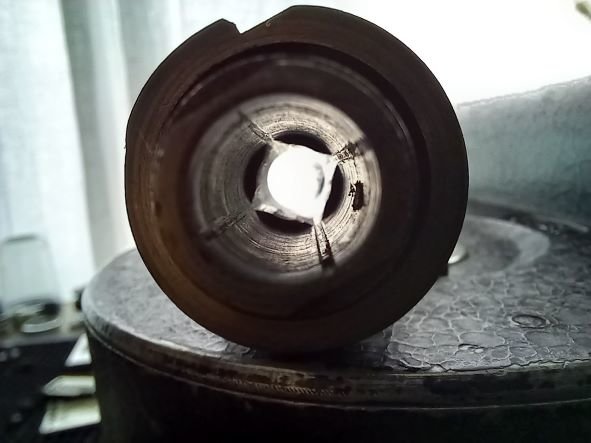-
Posts
2,588 -
Joined
-
Last visited
About Simon Wyss

- Birthday 12/02/1961
Profile Information
-
Occupation
Other
-
Location
Äsch
-
My Gear
Gauge blocks, gauge pins, calipers, micrometers, autocollimator, stereoscopic microscope, and everything a mechanic uses
-
Specialties
Cinema pioneers
Commercial hand processing of motion-picture films
Step contact printing
Mechanics
Contact Methods
-
Website URL
https://www.filmmechaniksimonwyss.biz/
Recent Profile Visitors
-
Dear Greg, a passage from your blog, Their company would later be shortened to Arri, and for the next 100 years Arri would be a dominant player in the film industry, seems a little far fetched to me. The truth is that Arnold & Richter were a small enterprise and not well known until 1952 when they began selling the ARRIFLEX 16. The ARRIFLEX, from then on coined ARRIFLEX 35, was sold perhaps 40 times up to the beginning of the war, I don’t know that precisely. Until February 1941 some 125 have been made. The Kine cameras of the 1930s were Askania, Bell & Howell, Debrie, Eclair, Mitchell, Vinten, Wall. Thousands of Debrie Parvo were in use when the ARRIFLEX appeared in 1937. ARRI printers are long forgotten (like others). An international player the company became with the 35 BL in the seventies. There have also been a KINARRI 16 and a KINARRI 9½. Only for completeness
-

Smudge/dark spots in my picture - what is the best way to fix this?
Simon Wyss replied to Lucas Xavier Simes's topic in 16mm
We don’t know. One thing I know is that funghi are metal eaters, some plants pull in heavy metals favourably, for example tobacco. That’s why the leaves are smoked, addiction to metal oxides and stuff. Lens coatings are metal oxides. Canada balsam is still in use, I have a bottle of. According to wishes I cement lenses with it or with an ultraviolet curing plastic. Both have their advantages and setbacks. The spores that can grow out are already in the fir resin when it’s collected in the forest. -

Smudge/dark spots in my picture - what is the best way to fix this?
Simon Wyss replied to Lucas Xavier Simes's topic in 16mm
This but to have that done by a person in the know. -

Smudge/dark spots in my picture - what is the best way to fix this?
Simon Wyss replied to Lucas Xavier Simes's topic in 16mm
Fungus, at least on the front surface of the double prism. The round spots you may want to try to remove. Clean the glass on both sides with cotton swabs moistened with alcohol, you can rub lightly first, a second time, new damp swab, a bit stronger. The coating holds well on the glass. Finally breathe on the glass, then polish with a dry swab. If the dots stay, try acetone. After that the double prism needs to be replaced. -

Arri Standard vs Bayonet mount for Wide Angle lenses
Simon Wyss replied to George Hill's topic in Lenses & Lens Accessories
Simple check: pull on the mounted lens and feel any longitudinal play. If snug, leave everything alone. If wiggly, give camera to service together with the lens. -
Film perforated on both sides doesn’t pose a problem with any 16-mm. camera. I have the impression that your camera needs some cleaning. Possibly it’s more than 70 years old, if an early DR. A service would bring it back to a like-new state. While at it a technician can measure flange depth and speeds, clean the critical finder, the turret finder, the mechanism including the release button and its bore. The money spent on servicing is not lost, it will be conserved as impeccable functioning, perhaps with a warranty.
-

Goodbye remjet, hello AHU?!
Simon Wyss replied to Joerg Polzfusz's topic in Film Stocks & Processing
A piece of black velvet can always be glued on a pressure plate. -

Goodbye remjet, hello AHU?!
Simon Wyss replied to Joerg Polzfusz's topic in Film Stocks & Processing
It is a colloidal silver layer in gelatine. Colloidal silver is black. -
Do feel free to ask me questions, if you deem the subject interesting enough for everybody. Maybe you want to find the way back to the original concept of the (Paillard-Bolex) 16-mm. turret movie camera. The Victor model 3 was first to afford that, some months before the Bell & Howell Filmo 70. The idea is to have ready a normal focal length lense, a wide angle, and a tele. The most used lengths are one inch, about ⅝ in. or 15 or 16 mm, and three inches. Two inches are also nice. The important aspect besides all optical finesses is compactness. Three C-mount primes are often lighter in weight than a zoom lens. If your model is from 1953, it has the early steel claw and a 190 degrees shutter opening angle. It may shake a little because the claw drive and the shutter aren’t counterbalanced.
-
Yea, there are a few things that are better made than with the Krasnogorsk. My principal concern about a K. is the rather insecure hook-up of the drive spring to the arbor. Maybe some series were okay but in the K. 2 I had to look into I had found this: The Bolex finder mask can easily be rotated with a large enough screwdriver after having removed the finder funnel cover, just while observing the position through the ocular.
-
Let me take you around the rock to have a different look at it. Instead of investing in a RX-1 that affords a narrow finder view on a small round base you might want to find a different model which opens optical freedoms a RX model doesn’t, or a younger RX which at least gives a wider finder view on a large base. With different model I mean a Standard one, H 16 S on the name plate from serial number 203551 on. A Standard H incorporates the rackover focusing and framing system that goes back to the Bell & Howell Standard Camera, model 2709. You have 100 percent of the light coming from a lens on the frosted front of a glass prism behind the upper lens port. Through a magnifying loupe you see the image on the prism. The reflex finder gives you 25 percent of the incoming light at best. The first Standard with that critical finder system bears the number 7531. Older Standard H models up to serial number 100,400 have 190 degrees shutter opening, later 170. Together with the wider shutter angle you have a deeply engaging claw made from steel plus lateral film guidance according to the norm (today ISO 466). H 16 S since 1963 have a bigger rectangular body base with three tapped bores for fixation. But what counts most is that the Standard models have nothing between the lens and the film but air (and the shutter). You can use almost any optics there are, be it a C-mount one, be it a LEICA lens via the original Leitz adapter or something else. For framing you employ a side finder attached to the camera lid. If a zoom lens, I’d search for a modern one. There are very compact ones, not that long and wieldy. TV lenses can be so-so, some are excellent. A third approach could be to purchase a bayonet model, SB/SBM/EL, and a Vario-Switar 12,5 to 100 (Aspheron or not). This is a sturdy and optically satisfying equipment. It all depends on which direction you’re taking in cinematography.
-
It does, with my brain and soul. Where does this obsessive wish come from to have large lenses on a camera that was made for smaller, more compact, more lightweight, and optically perfectly fit ones? I don’t get it. C-mount optics are good enough, actually better, can be had for little money and look exactly right. Also the choice is wide. It’s vast.
-
Over the years you accumulate data, knowledge. It can get complicated sometimes but also interesting: https://forum.mflenses.com/wollensak-cine-raptar-1-inch-f-1-5-what-is-it-t82922.html We haven’t spoken of many other manufactureres, yet. Berthiot, Leitz, Optikotechna/Meopta, Ernitec, Boyer, Sun, Laack, Nikon, Meyer, Zeika, Canon, Ling, DJS, Veydra, Ichizuka, Soligor, Walz, Kowa, Anstron, Fuji, Unitel, Cinetor, Tewe, Astro, Rüo, Enna, Krauss, Wray, Ross, Voigtländer, Busch. The Kern-Paillard Compact Vario was a licenced Pan-Cinor Berthiot.
-
YVAR was the economy class, basically triplets. Stereo-Yvar: two triplets. Macro-Yvar are dialytic four glass. The Yvar 75-2.5 is a classic Cooke triplet but the 75-2.8 has a thick center negative unlike everything known until its appearance. Similar the 36-2.8 for 8-mm. film. PIZAR form the middle segment, five-glass normal or mild telephoto or less opened wide angle lenses. SWITAR is the premium line. Still, the six-elements normal was made without depth-of-field indicator and branded PIZAR 25-1.5. Then the 50 mm Switar, f/1.4. 75 mm, f/1.9. The 5,5 mm wide angle consists of five cemented doublets, Switar or Pizar identical glass, just different apertures. Bigger sister 10-1.6. Entirely new designs were the Switar and Macro-Switar for the Paillard-Bolex H-8 Reflex. VARIO-SWITAR. These had begun with 16 elements. The 12,5‒100, f/2 has 19 elements.








